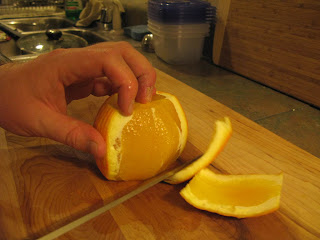
This is kind of useless if you don't have a zester, but if you do, it's very simple. If you don't have a zester a microplane or fine cheese grater works great, but you only get the long strips of zest with the zester.

Hold the orange as shown with the zester being held by your fingers, and your thumb on the bottom of the orange.
Then rotate the orange keeping the zester on the peel, creating strips that should be a long as 1/2 the circumference of the orange

You want to zest from the navel to the stem.

Next, orange supremes, which are wedges of orange with no skin, pith or membrane.
Cut off the top and bottom of the orange.



Now, take your knife, and starting near the tip of the blade, with your blade at an angle, slice down, pulling the knife towards you, slightly turning the blade so that your cut follows the shape of the orange.



Rotate the orange and keep doing it until the peel is gone.




Now, hold the orange in your hand, and line up your blade with the lines that create the segments, and move over just a tiny bit.
You don't want to cut into the parts that segment the orange, but right next to it, because your final product should have none of the membrane.

Slice away from you, down into the center of the orange, pull the blade out, and line it up with the other side of that same segment.

Slice into it, extracting your perfect segment.

Continue with the rest of the orange, extracting all the segments.


These are very tasty little segments, especially if you don't like the bitterness of the membranes (even though that's where all the fiber is).
Some good uses for these are for tarts, decorative tops for cakes, salads, and you can even soak them in pretty much any liquor for a few days. This imparts orange flavor in the liquor, and take them out of the liquor and they are tasty little boozy orange segments!




































